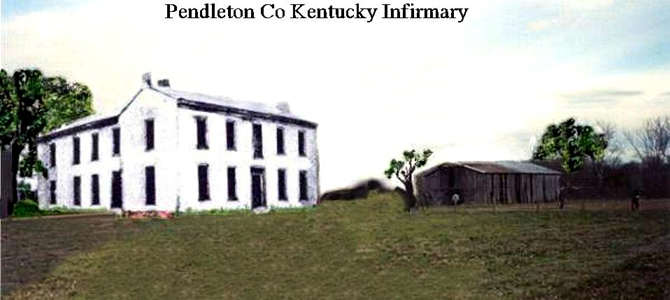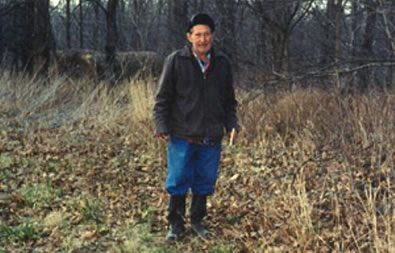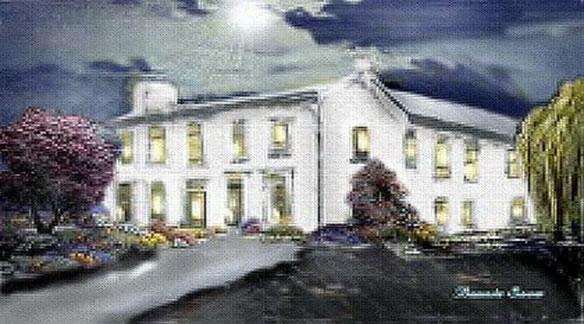
The Pendleton County Infirmary
![]()
Submitted by Greg Justice & Nancy Bray.

The above picture is the Infirmary and the actual site on which it was located.
Please Note: The Infirmary is no longer standing.

On March 19, 2001 we had the pleasure of meeting with Mr. Stanley Bishop, of Hays Station Road, and taking a tour of the old infirmary grounds. We being Nancy Bray, and myself, Greg Justice. We first visited the newer cemetery which is located in the back yard of Roy and Janice Green. Stanley Bishop had a tombstone placed at this grave site, and gave the information for the known people that were buried there. John Peoples, of Peoples Funeral Home, had donated the stone. Those that are named on the stone are as follows: Justice - d. 1938, William Jasper Fogle - d. 1939, Levi Sargent - d. 1948, Nancy Kelch - d. 1939, William Button Jones - d. 1938, and Dorcella Bloom - d. 1951. Roy and Janice Green have this area cleared and have planted irises at the site.

As we walked along the grounds we found pieces of the old infirmary walls, and what we believed to be the cover for the old well, it having been filled in for safety purposes.
Stanley then took us to the old cemetery that was about a half a mile or so from where the infirmary stood. This cemetery holds about 25 plus graves, and even though there use to be stones marking the graves, we were unable to find any at the time. According to the files that Stanley Bishop has, buried at this site are: Alex Clayton, Nancy Clayton, Taylor White, Edd Johns, Ed Max Fields, Rebecca Thompson, Mary Gray, and Edd (Wart). There are several more which are unknown at this time. This area lies along the South Licking River.

Site of the Old Cemetery
Stanley's father, Major Bishop, was the caretaker of the infirmary from 1924 thru 1936. Stanley and his brother Chester were lads growing up there, and helped out on the grounds. Major Bishop was the caretaker there at the time of the death of Nancy's great grandfather Alvin McCann, who died in 1927, and is buried on the grounds of the old cemetery.
Stanley states that the infirmary was also known as the "poorhouse", and that many people had passed through here. This was home to some, to others just a place to stay until they were able to make it on their own, and to others a place to ready themselves to cross over from this life. The infirmary is a great piece of Pendleton County history
After the infirmary closed it doors as a county home, it was rented as a tenant house for a while. In the last days of the infirmary building it was in ruins, and then was finally torn down several years ago. A large red barn stands in its place today, and the owners of the property have taken care that the grave sites have not been disturbed.
This was a very interesting visit, and we have several pictures to remember it by.
Greg Justice & Nancy Bray
Nancy's Note: One can only imagine what the infirmary must have looked like when it was first built. I have heard that it was built by an Oldham before the Civil War, and it must have been a showplace.

The above picture is a rendition of how it might once have looked by Mrs. Bonnie Snow.
Beautiful Once
Written by M. Elaine Yelton of Pendleton County Middle School.
Transcribed & Submitted by Nancy Bray, thanks Nancy!
The lonesome, old house that served as the Pendleton County Infirmary was supposedly built by Thomas Jefferson Oldham before the Civil War. The 'poor house' is located on the banks of the South Licking River approximately one mile from Falmouth, Kentucky on Hayes Station Road. This white brick building housed many people. Some were down on their luck, but others had been poor all of their lives.
During the early 1900's, mainly the owners did the cooking and housekeeping. Sometimes, some of the able bodied inmates would help with the cooking. They would cook food that was displeasing to themselves and give it to the others. Then they would cook better food and eat it themselves.
Between 1902 and 1910, Mr. Charles Ruber was the manager of the infirmary. Mr. Ed Ruber, Charles' son, was his assistant. When the Rubers left on March 1, 1910, they recorded an inventory and cash balance of $1,140. This included farm products such as potatoes, corn, hay, fodder, and tobacco. It also included such necessities as meat, salt, coal, wood, and lard.
The Rubers also recorded admittances and deaths during the eight years as proprietors. There were forty-four admittances and nine deaths. If the deceased did not have any family, they were buried in one of the two cemeteries located in the fields surrounding the infirmary.
In later years, things changed quite a bit. Mr. Roy McClanahan became proprietor in either 1939 or 1940. His wife and daughter moved in, too. The infirmary had two different parts to it. One part was brick. That was where the regular occupants lived. The proprietors and their families lived in the newer, wooden section.
When the McClanahans first moved in, the whole place was infested with lice. There was the burning of many mattresses and scouring of pots, pans, and dishes before the infirmary was decently clean.
The inmates had to be watched carefully. Many people took off their dirty clothes and mixed them in with their clean ones. One old man chewed tobacco. When he had to spit, he did it in a drawer all over his clean clothes. Another lady wore old-fashioned dresses and petticoats. She was the only one who had them. On wash day, the ladies washing the clothes gathered them up. After the clothes were washed and dried, they were returned to the correct owners. Or, at least, they tried to return them. The old lady with the long full dresses and petticoats always said that the clothes brought to her belonged to some other person. This happened every wash day.

Patrons of the Pendleton County Infirmary
Front Dorcella Bloom, Sally Bishop, Nancy Kelch, Leir Sargent, and William Jasper Fogle.
Back:
William Button Jones, Frank Cushman, and Mr. Harcum.
A black and white copy of this picture was generously provided by Mr. Stanley Bishop; thanks Stanley!
For entertainment, the people usually amused each other. On Sundays, maybe a group of singers from a nearby church would stop by and sing for a while. Sometimes, they would bring the lonely people some kind of treat. On Saturdays, some of the healthier people would walk to town and buy things with the money that was brought by some generous visitors. The children had a swing to play on, old broken dishes, and mud which to make mud pies.
If the youngsters were able, they would help carry in water and coal. They rarely had to help with the cooking. Sometimes, children would be sent to an orphanage if their parents had to go to the infirmary. The children that were fortunate enough to stay with their parents usually lived in the same room together as they would in a regular home.
For some of the people living in the infirmary, it was a better way of living than they had ever had, or had hoped to have. For others, it was all they could remember. One lady's husband was in prison for several years. She came and brought her children with her. She reared the children as if the infirmary was the home they had had all of their lives. When her husband was set free, she rounded up her children, packed her luggage, and left.
If people had a place to go, they always left. Sometimes, a lady would be good at housekeeping. If anyone needed a housekeeper, they would tell the women in the infirmary. If one of the women would clean the person's home, she could go live there. Sometimes, a relative would drop by and pick up an inmate.
The majority of the people of the infirmary were poor. Some were mentally ill and had no place else to go. Sometimes, hobos walking down the railroad tracks would stop by and beg for a free meal.
In 1958, Pendleton County sold the infirmary, half and half to Mr. and Mrs. William D. Jacob and Mr. and Mrs. James L. Jacob for $27,000. Mr. William Jacob died so now all the land belongs to Mr. James Jacob.
Ann Dance was the last person ever to live in the infirmary. She rented it for one month and then she moved out.
The infirmary is now in a terrible state. There is not a single pane of glass in any of the number of windows and doors. The kitchen floor has fallen in to make it and the basement one big room. Nothing can be salvaged. There are old bed springs in one room, along with the stove and ironing board also there. Tangled vines have grown over the ancient, rusty water pump. Any sign of recent habitation has vanished. The fourteen-room former mansion is headed for certain destruction in the years to come.
References from Pendleton Co. Courthouse, Mrs. Zelphia Ruber, Mr. Ambrose Fields, Mrs. Wilma Wolfe, and Mr. and Mrs. Robert Gifford.
Updated:
Below is a list of burials of people that passed away while living at the infirmary/poorhouse, and are buried there. This information was taken from a book of Woodhead burials 1892-1996. This wonderful book was compiled by Col. Douglas A. Harper.
Mrs. Minerva Blackburn d. 12-03-1921 age 75
Wm. Boone d. 4-9-1947 age 69
Riley Carr d. 12-11-1909 age 80
Nancy Clayton d.11/25/1918 age 80
Clemons d. 2/18/1910
Pat Flairty d. 4-19-1908 age 95
Robert Fogle d. 9-8-1906 age 71
Flosy Gulidy d. 7-15-1906 35
Rosey McGill d. 4-3-1911 age 65
Walas McGill 6-14-1918 age 78
Lou McKiney d. 1-18-1917 age 84
Nancy Miller d. 12-6-1902 age 90
Abe Norris d. 7-23-1908 age 74
Mrs. Emily Northcutt d. 10-17-1911 age 85
Fain Brown Ogletree d. 1-29-1912 age 30
Joseph Pettit d. 3-17-1911 age 75
Child at Poorhouse d. 3-1-1899
Child at Poorhouse d. 4-10-1899 age 1
Billy Redman d. 3-19-1949 age 78
T. Richardson d. 2-4-1912 age 70
Levi Sargent d.5-10-1948 age 80
Rebeca Thompson d. 3-4-1920 age 75-80
Grant Tole d. 3-18-1903 age 84
John Welch d. 9-4-1910 age 86
A. J. Wells 11-20-1911 75 years
Daniel Wolfe d. 5-3-1911 86 years
Note:
There was a statement about the graves being plowed up and this is not true (statement has been removed). I have personally been there and have seen where the graves are. In fact my great grandfather is buried there, and would have been upset had the statement been true. The statement is very disturbing to a lot of people who know better.
Nancy Bray October 24, 2010
![]()
Problems or bad links should be reported to the webmaster. NOTE: These records have been transcribed from several different sources, either by us or by other researchers and provided as a starting point to assist you in your research; we've verified as many as we could, but be aware that there may be errors (either mis-spellings on the original records, almost illegible writing on the records, and/or typing errors on my part), so make sure to double check them prior to assuming they're "the gospel truth". We will never deliberately include erroneous information in any part of this site. ©Copyright 2005-2018 by Pendleton County Genealogy Project All files on this website are copyrighted by their submitter and creator. They may be linked to, but may not be reproduced on another website or in any other form, without specific permission of
the submitter, owner, publisher and this site moderator. Although public records are as such not copyrightable, the manner in which they are presented, including the notes, comments, etc. are. The information on this site is provided free of charge, by volunteers, for your personal use
only.
These records have not been copied by either of this site's coordinators from other sites, as has been implied by some. Sources have included records from the E.E. Barton research files, military records, newspapers, microfilm and/or compiled lists that were provided by family members and other researchers. If you have records that you'd like to see added to this site, please contact either Sherri or Suzanne and we'll be glad to add them to this collection.
